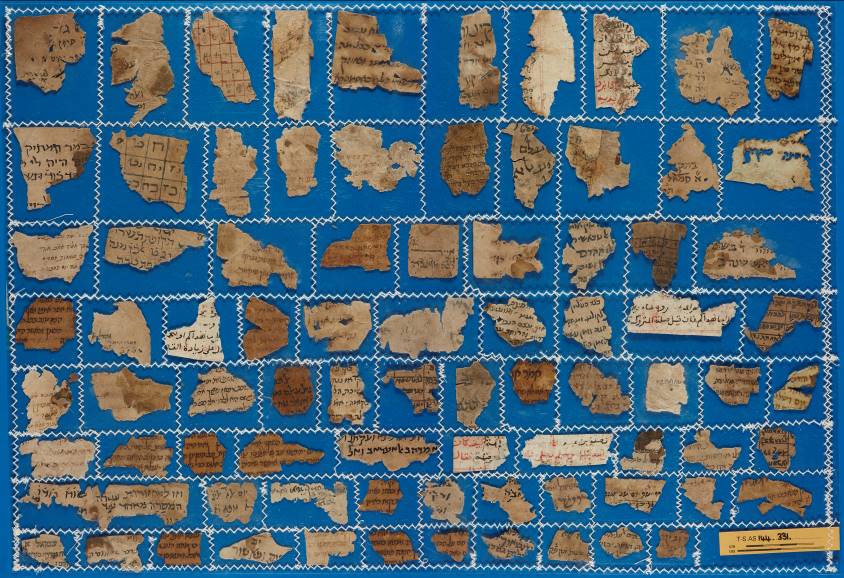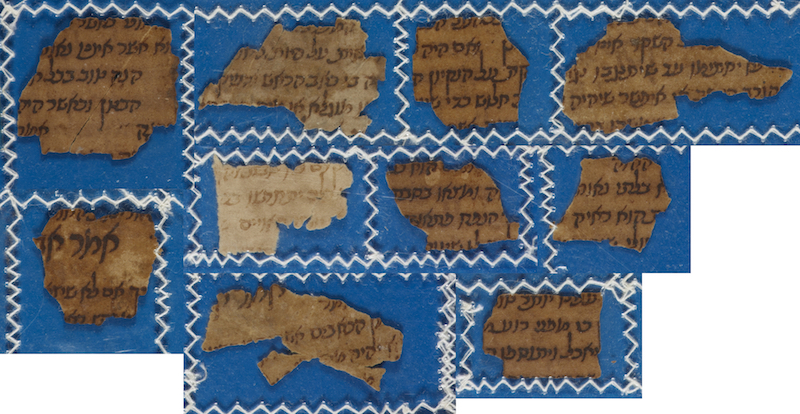The Long Art: T-S AS 144.331
“Life is short, the art is long.” So begins one of the foundational texts of Greek medicine, the Aphorisms of Hippocrates. The ‘art’ of which Hippocrates wrote was the knowledge and skill to be acquired by physicians, but the sentiment has been expressed in other contexts, not least of which is R. Tarfon’s saying, “The day is short, the work is great” (mAvot 2:15). Faced with hundreds of thousands of textual fragments, far too many still unidentified, researchers of the Cairo Genizah might sometimes feel the same. But the increasing number of catalogs, digitization of fragments, and other electronic sources are helping make the research more productive than ever, even for a newcomer to the field such as myself. And so, I’d like to share with you a story about T-S AS 144.331.
The shelfmark in question is actually a collection of 82 small fragments from numerous different sources, some in Hebrew, some in Arabic, and some with little or no legible text.

T-S AS 144.331, Front (1r and 2r digitally combined)
If we look at a fragment more closely, we can see just how difficult identification might be:

Bottom row, fifth fragment from the right. Left image: Front. Right image: Back.
On the front, only three words (“they are on” and “he/it saw”) are visible in full—words so common as to be practically useless for identification. The back offers even less. Are such fragments destined to remain unidentified pieces of the collection? Is it hopeless?
I first encountered T-S AS 144.331 while preparing a manuscript list of Hebrew translations of the Aphorisms of Hippocrates. In the course of my research, I consulted the catalog Medical and Para-Medical Manuscripts in the Cambridge Genizah Collections (Cambridge University Press, 1994) by Haskell Isaacs, who carried out the extraordinary task of describing more than 1600 medical fragments, including several that he identified as the Aphorisms. I started working my way through them, but I was particularly intrigued when I came to item no. 1058, our shelfmark T-S AS 144.331, which reads in full:
Minute fragments: Eight of these relate to Maimonides’ commentary on Hippocrates’ Aphorisms in the Hebrew translation of Moses Ibn Tibbon; too minute to give precise references.
It is astonishing that Isaacs recognized anything among these fragments, but he evidently had the text on hand for the identification of larger fragments of the text, and some words and phrases are more telling than others. I attempted to confirm the presence of these fragments. And unlike Isaacs, I had on hand an electronic, searchable version of the text (thanks to Gerrit Bos). I worked through the (legible) Hebrew fragments in the group and found textual matches for not eight but rather eleven pieces. In addition to the fragment shown above, here are the ten others (showing front side only):

Looking at the fragments together, one thing was clear: They are all written in the exact same hand, which can be identified as a fifteenth-century Sephardic semi-cursive script. I realized that they were probably all from the same manuscript. I immediately began to wonder if any of the other fragments of the Aphorisms were from the same manuscript. I remembered that some of them were written in Sephardic scripts, but I had viewed them separately and with more attention on confirming Isaacs’s identifications than with the relationship between one fragment and another. When I went back to them, I found that these eleven fragments, along with 24 others, were all written by the same hand. As it turns out, these fragments were once part of a manuscript produced in Iberia in the fifteenth century and eventually carried to Egypt—probably as a result of the expulsion of Jews from Spain (1492), Portugal (1497) and Navarre (1498).
With my full list of textual identifications, along with the digital images generously supplied by Cambridge University, I was able to reconstruct several pages of the original manuscript and connect nine of the eleven fragments to other pieces. To offer only two examples, three of our small fragments connect to T-S AS 143.442 (left) and two fragments, including the ‘hopeless’ one discussed above, connect to T-S AS 144.3 (right).

I am now preparing a technical study that will discuss the reconstruction in detail. But the lessons and optimistic outcome of the work should be evident even here: there are still many wonderful discoveries waiting in the Cairo Genizah, and the new tools at our disposal, not the least of which are the ongoing efforts by Cambridge and other libraries to digitize and catalog the fragments, will help us find them. Life may be short, and the art may be long, but these developments are making the Cairo Genizah more accessible than ever to specialists and non-specialists alike.
Acknowledgement
The underlying research was carried out thanks to a fellowship from the Edelstein Center for the History and Philosophy of Science, Technology and Medicine (The Hebrew University of Jerusalem).
Cite this article
(2016). The Long Art: T-S AS 144.331. [Genizah Research Unit, Fragment of the Month, December 2016]. https://doi.org/10.17863/CAM.7223
If you enjoyed this Fragment of the Month, you can find others here.
Contact us: genizah@lib.cam.ac.uk
